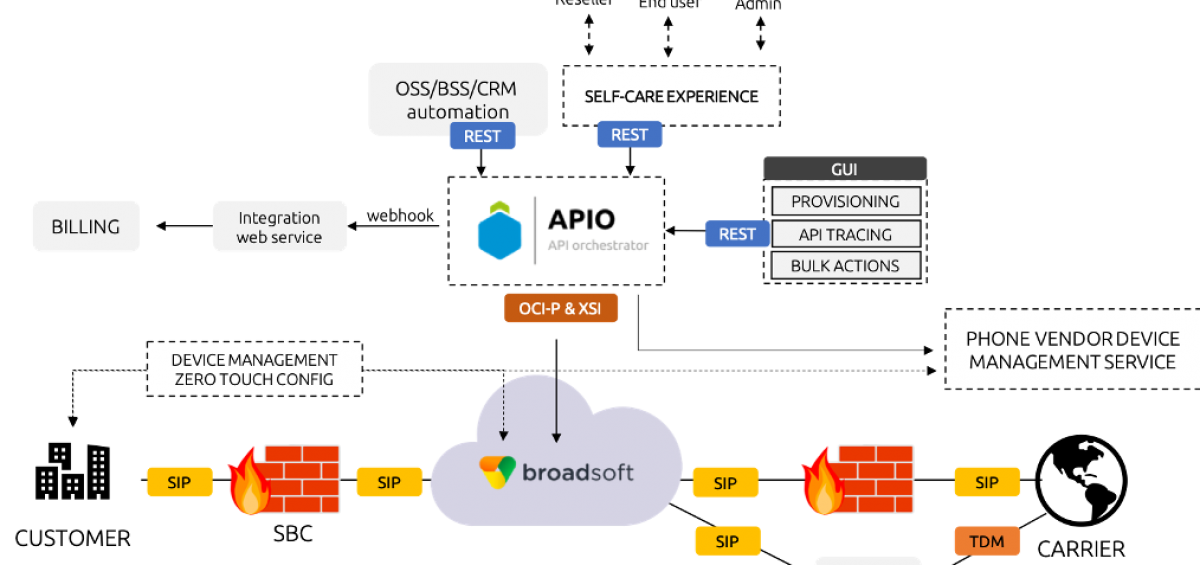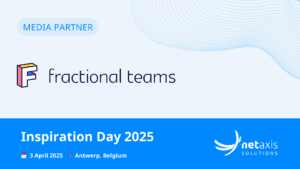Use of APIO as a Loki replacement
This post discusses the use of Netaxis APIO as a replacement for the Cisco Broadwords Loki provisioning platform.
Cisco Broadworks
Cisco Broadworks is a SIP based voice and UC platform, originally built by Broadsoft. Broadsoft was acquired by Cisco in February 2018. The Broadworks platform is used by hundreds of service providers worldwide to deliver B2B voice services such as SIP trunking, hosted PBX and UC as a Service.
One of the key strengths of Broadworks is the fact that it can provide a feature rich hosted/cloud alternative for onsite telephony exchanges (ie PBX) while being deployed centrally. The platform is fully multi-tenant, meaning that you can use the same platform to serve many different customers.
Changing consumer habits
The habits and requirements of consumers have changed dramatically in the last decade or so. The rise of the internet has not only changed dramatically the way people interact with each other but also with businesses. Consumers are used to instant satisfaction of their needs and wishes. Everything can be found and ordered online and at any time of the day. In the case of digital products (e.g. Netflix, Spotify) going from order to consumption is just a matter of seconds.
The B2B telecommunications market has been slow on the uptake where digital gratification is concerned. Most of the processes for fulfillment and provisioning of B2B telecommunication services are only partially automated and sometimes have no automation whatsoever. Customer experience is more important than ever and customers want to have control on their services. They want to manage their services themselves without having to rely on help desks with the accompanying music on hold, or having to wait for a support desk to reply to a ticket. Moreover, they want to see what they consume and when they have consumed it.
The Netaxis API Orchestrator (APIO) is a platform created in order to facilitate B2B fulfillment processes as well as to create digital experiences to improve the B2B customer experience.
The challenges associated with integrating Broadworks
Due to its hierarchical data model and the large number of user and company level features the IT integration of a Broadworks platform into the OSS/BSS (IT) stack of a service provider is far more complex than for many other telecom products and services. Moreover, in many cases, for example in an IMS deployment, provisioning is not only required on the Broadworks platform but also on neighbouring IMS elements.
Moreover the platform lacks an easy-to-use out-of-the-box user interface that can be exposed to customers to self-manage their solution. The last effort made by Broadsoft in that context was the acquisition of Leonid Systems, a software company specialized in building selfcare portals for Broadworks. In particular the Loki provisioning platform was widely adopted by Broadworks users. Following the Cisco activity, support for the Loki platform was ended.
Many service providers have spent a lot of time and effort (read money) on integrating their systems with the Broadworks platform. Many stumbled over the complexity of the Broadworks API which does not hide the underlying complexity of the Broadworks platform. Significant Broadworks expertise is needed in order to be able to use the API. Moreover this API uses OCI-P which is a proprietary non-standard XML over TCP API protocol and not every attempt at integration is wholly successful. Where integration efforts have succeeded this is usually at the expense of flexibility. A change in the underlying Broadworks platform (eg new release) often requires big changes at multiple levels to the IT infrastructure. This is complicated when the original engineering resources used to do the work may no longer be around or available. APIO is a replacement for Loki.
How does APIO help with Cisco Broadworks implementations
APIO is a platform that eases the development and automation of the operation and integration of Broadworks platforms and enables service providers to build digital experiences on top of BroadWorks with a fraction of the normally required effort.
 APIO is built using an API-first approach. APIO exposes developer friendly and easy to understand REST APIs that hide the complexity of the underlying network elements. It acts as a single northbound (provisioning) interface for the entire solution. APIO does not only connect to BroadWorks, connectors are gradually added to interface with other, surrounding, elements in order to provide a full solution. A workflow engine is shipped with the product that facilitates higher level orchestration across different network elements.
APIO is built using an API-first approach. APIO exposes developer friendly and easy to understand REST APIs that hide the complexity of the underlying network elements. It acts as a single northbound (provisioning) interface for the entire solution. APIO does not only connect to BroadWorks, connectors are gradually added to interface with other, surrounding, elements in order to provide a full solution. A workflow engine is shipped with the product that facilitates higher level orchestration across different network elements.
APIO complements the Broadworks solution by easing integration:
- Ease integration into the IT systems of the service providers to automate onboarding and reduce manual provisioning workloads
- Digitalization of the user experience:
- Provide customers the ability to manage their virtual PBX environment easily
- Secure zero touch provisioning of devices
- Just ship devices to the customer
- Let them just configure the device via the self-care portal
- Plug & play!
- Mass updates on the install base
- Usage and license reporting/analytics
APIO can expanded to use cases that go beyond Broadworks
APIO at a glance
APIO acts as a central API gateway exposing REST APIs to the external systems. Northbound API calls trigger actions on southbound network elements. To orchestrate complex business logic across multiple network elements APIO comes with a workflow engine that provides a visual definition of this logic. The workflow engine supports REST API calls (HTTP+JSON) and talks to complex southbound non-REST APIs via connectors.
 Gateways
Gateways
- Broadsoft gateway: REST API for Broadworks which includes features like templating, support for resellers
- Phone vendor gateway: REST API to automatically configure the redirect servers of phone vendors in the context of zero touch configuration of phones
- HSS & ENUM gateway: REST API to configure subscriptions and records in the IMS related databases
- More gateways will be added (e.g. SBCs)
APIO Core
- Workflow engine:
- Allows to do high level orchestration over multiple API endpoints and gateways
- Possible to build API logic via the GUI
- Ability to define your own API endpoints and link them to workflows
- Proxy functionality
- Define one or more API proxies which (if required) authenticate requests before proxying them to the underlying gateway
- Add multiple proxies, allowing to server a multi-platform environment from 1 single unified API interface
API logging
- Historical search on all API calls that came by on the system
- Trace back details of the executed orchestration logic and southbound commands
Bulk
- Upload a CSV or other spreadsheet and create a work order per line in the spreadsheet
- This allows to call our APIs in bulk
Provisioning GUI
- Graphical interface to do provisioning on the system using the Netaxis REST API
Webhooks
- Define events about which you want to be informed (e.g. a POST on a certain endpoint)
- Define the webservice that needs to be informed
- Allows a smart integration of API with 3th party systems
Analytics (in development)
- ELK stack used to provide advanced insights on the usage of the platform
Selfcare portal (last but not least)
- A customer facing portal which allow enterprise admins, resellers, group admins and users to self-manage their configuration of the virtual PBX
- Out of the box only non-billable changes are supported
- In combinations with the webhook capabilities as well as the workflow engine, it becomes possible to extend to also support billable changes (requires additional integration effort).
So there you go. Netaxis APIO replacement for Cisco Broadworks Loki at a glance. If you are a service provider offering services based on Broadworks and need a Loki replacement please do get in touch via our contact page. This post was written with help from Bart Coelmont.
For more spiel go to APIO page or find another blog post on integration here.




 Gateways
Gateways

